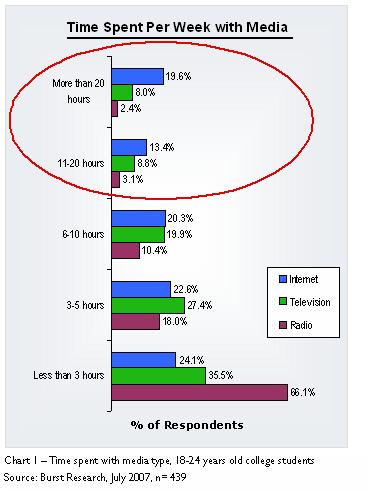Internet Media Is The Way To Reach College Students
Jul 26th, 2007 | By James Lewin | Category: Audio Podcasting, Digital Music, Digital Video Downloads, Internet TV, Making Money with Podcasts, Podcasting Research, Podcasting Statistics, Streaming Video, VideoBurst Media has released the results of a survey on media consumption of 18-24 year old college students, reporting that students spend more time with the Internet than with other media. Burst also reports that Internet audio and video were two of the students’ top reasons for using the Internet.
According to Burst, many students spend are spending more time with the Internet than any other media:

Internet Media Is The Way To Reach College Students
Burst recommends Internet media as the most effective tool for reaching college students.
“The 18-24 years segment has fully integrated the Internet into their daily lives. In fact, for a significant proportion of the segment, the Internet is the primary communication vehicle, information source, and entertainment channel ‚Äì in short it is the media of choice,” according to Burst. “Use all of the engaging creative options, from rich media to video units, the Internet offers.”
Report Highlights:
- One third (33.0%) of college students spend more than ten hours per week on the Internet, and 19.6% spend more than 20 hours per week online.
- Among college students, Internet usage levels surpass those of television and terrestrial satellite radio.
- While one in three college students are heavy consumers of the Internet, only one in six (16.6%) watch more than ten hours per week of television and merely 5.5% listen to terrestrial/satellite radio more than ten hours per week.
- College students are multi-taskers – often consuming different media simultaneously. In fact, one-half (50.6%) of college students surf the Internet while watching television and 43.5% are online while listening to terrestrial/satellite radio.
- Top activities for students include downloading music (53.3%), listening to Internet radio (44.5%) and viewing streaming video content (42.6%).